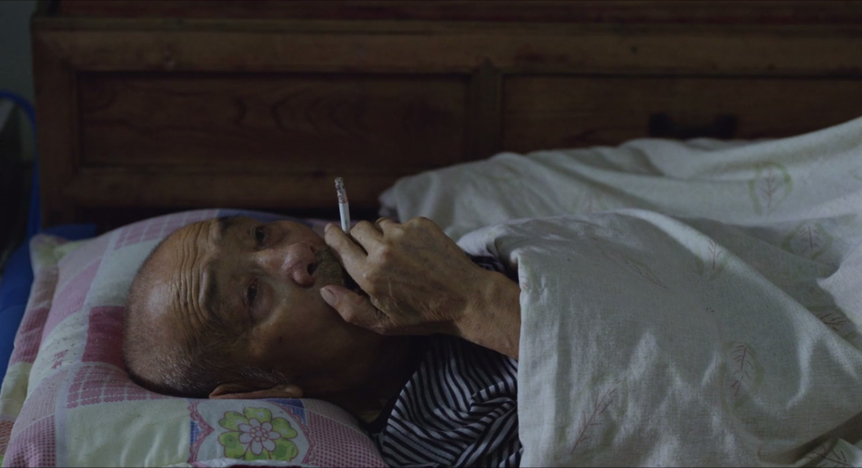-
From Current Issue
-
- Editor’s Letter Fire in the Heart
- Reviews I Gusti Ayu Kadek Murniasih
- Reviews 11th Seoul Mediacity Biennale: “One Escape at a Time”
- Dispatch Networked China
- One on One Monira Al Qadiri on Yukio Mishima
- Essays The rise of independent art spaces in pandemic-era Shanghai
- Features Tuan Andrew Nguyen
- Table of Contents
- Web Exclusives
- Archive
- Subscribe

R
E
V N
E
X
T
Installation view of HE XIANGYU’s The Yellow Swim Caps, 2016, single-channel video with color and sound: 17 min 23 sec, at “Evidence,” White Cube Bermondsey, London, 2018. All images courtesy White Cube, Hong Kong/London.
At White Cube’s Bermondsey gallery in London, He Xiangyu’s recent work provided a view into life along the Yalu River that forms the border with North Korea, near the artist’s hometown of Kuandian, China. In the auditorium, there were daily screenings of the feature-length documentary-type film The Swim (2017), while in the galleries, a pair of single-screen videos was presented, including The Yellow Swim Caps (2016), which features the artist’s attempt to swim across the Yalu River, a body of water which to He represents the social and political divisions of the region.
In comparison to the Korean Demilitarized Zone and mainland China’s frontier with South Korea, this stretch of territory, defined by the natural barrier of the river, is for the most part absent from historical narratives describing the Cold War-era carve-up of the peninsula. However, as revealed in He’s works, there are many commonalities to be found in the experiences of those living along any border with stark economic expectations. In The Swim, the ongoing influence of the Cold War stalemate on contemporary life is explored through interviews with Chinese veterans of the Korean War and testimonies of North Korean refugees who have illegally crossed the border in search of a better life.
In the film, the veterans talk of the hardship and trauma of the war with a candor that may be revelatory to European viewers—in their history books, the Korean War was one of the several “forgotten” wars of the 20th century—while displaying chests full of medals and residual pride at having withstood the economic superiority of the United States. The North Korean migrants tell equally harrowing tales of childhood poverty, famine and their struggles to survive at home before being trafficked to China and sold into forced marriages. These stories are familiar, having been discussed in recent years via a number of artwork that deal with the various migrant global crises. In these Korean women’s interviews, especially when shown alongside that of the veterans, there seems an indication that these movements are taking place against the Communist flow of history. The pairing and cutting of the footages opens up a dialogue between the two sets of interviewees. The cause for which the veterans fought is replaced by contempt, expressed by the Chinese veterans toward the Korean migrants, who are reduced to just another commodity to be traded.
The bucolic scenes of both The Swim and The Yellow Swim Caps conceals that the Yalu River and its surrounding terrains was dramatically contested during the Korean War. The artist shows picturesque mountains, waterfowl and boatmen, giving the impression that the traditional Asian pastoral landscape has remained unchanged for centuries, when in reality, bridges were blown up during the conflict, the truncated remains of one which can be briefly seen in the work. The broken bridge represents China’s continuing effort to isolate North Korea, ironically recalling the Cold War crusade of US general Douglas MacArthur, who presented the war as a campaign to prevent Chinese communism “contaminating” Asia.
The river He and his companions struggle to swim across in The Yellow Swim Caps is a metaphorical marker of the historical limits of various national narratives. The bodily struggle of the swimmers through the river is part of an exercise by the artist to directly experience the physical trials of life on the margins of territories and the influence this has on the psychological bearings of an individual. Opposite this work was Evidence (2017) a video in which He repeats the action of balling up scrap metal by hand, something that is an occupation for North Korean scrap traders who work along the border. A series of the original metal lumps was shown in a line around the wall of the adjoining gallery alongside the actions demonstrated in He’s video, in a kind of Mark Dion-style anthropological installation. The work provides a very stark overview: despite the grandiose claims of the ideological and political opponents who have fought over this stretch of land, and the sacrifices made by individuals to secure a position within it, the material benefits, as represented by the metal lumps, is meager.
He Xiangyu’s “Evidence” is on view at White Cube Bermondsey until April 8, 2018.
To read more of ArtAsiaPacific’s articles, visit our Digital Library.







